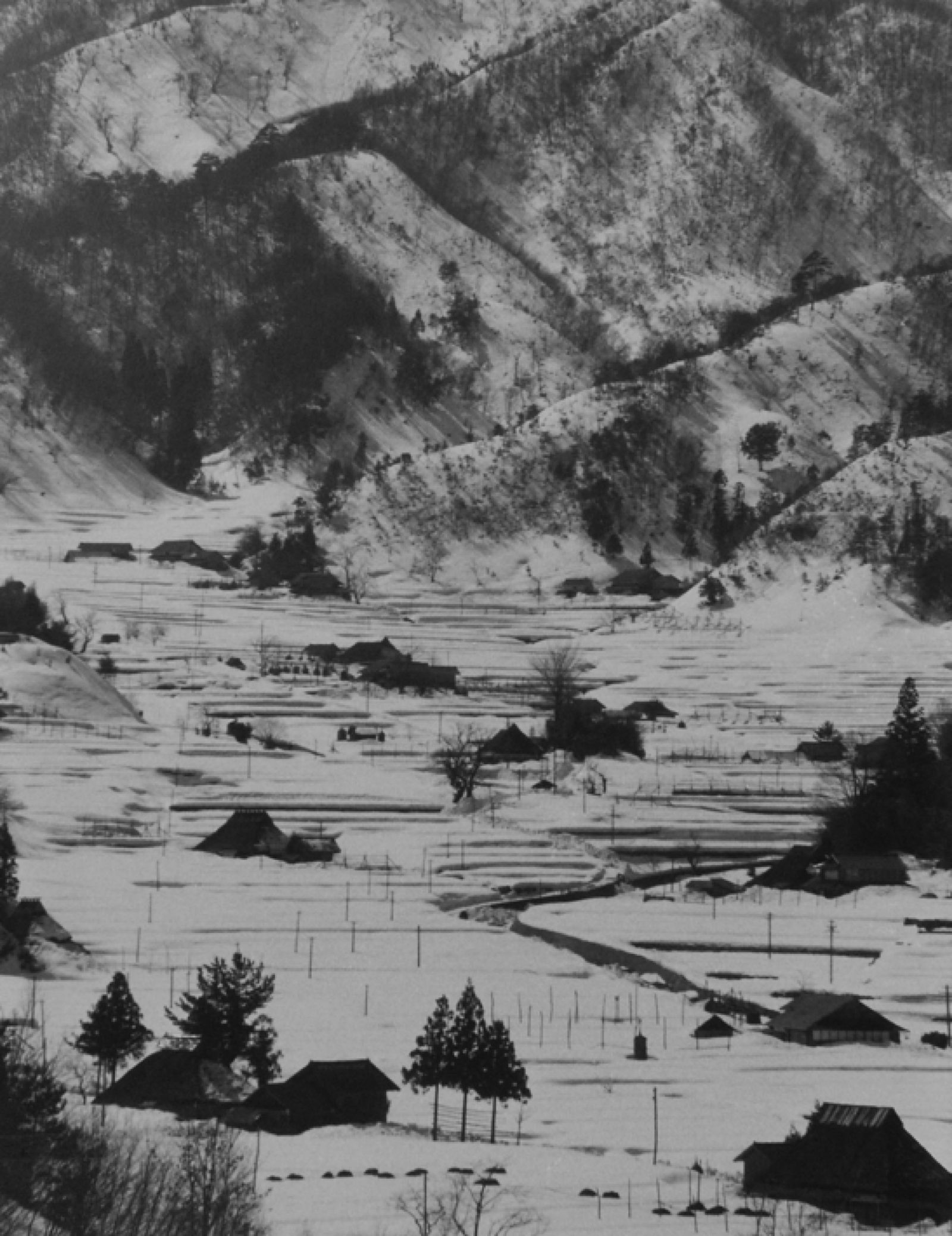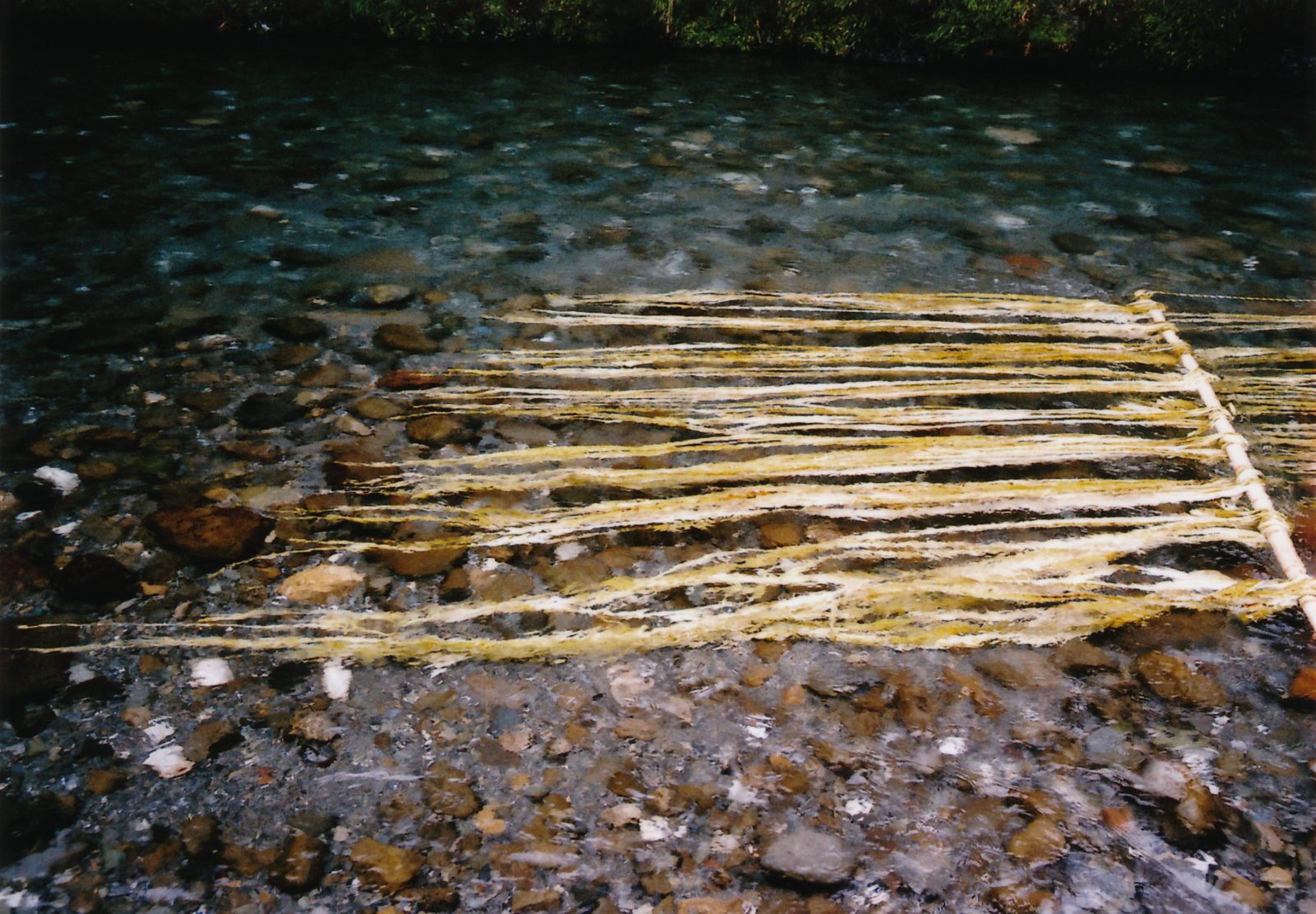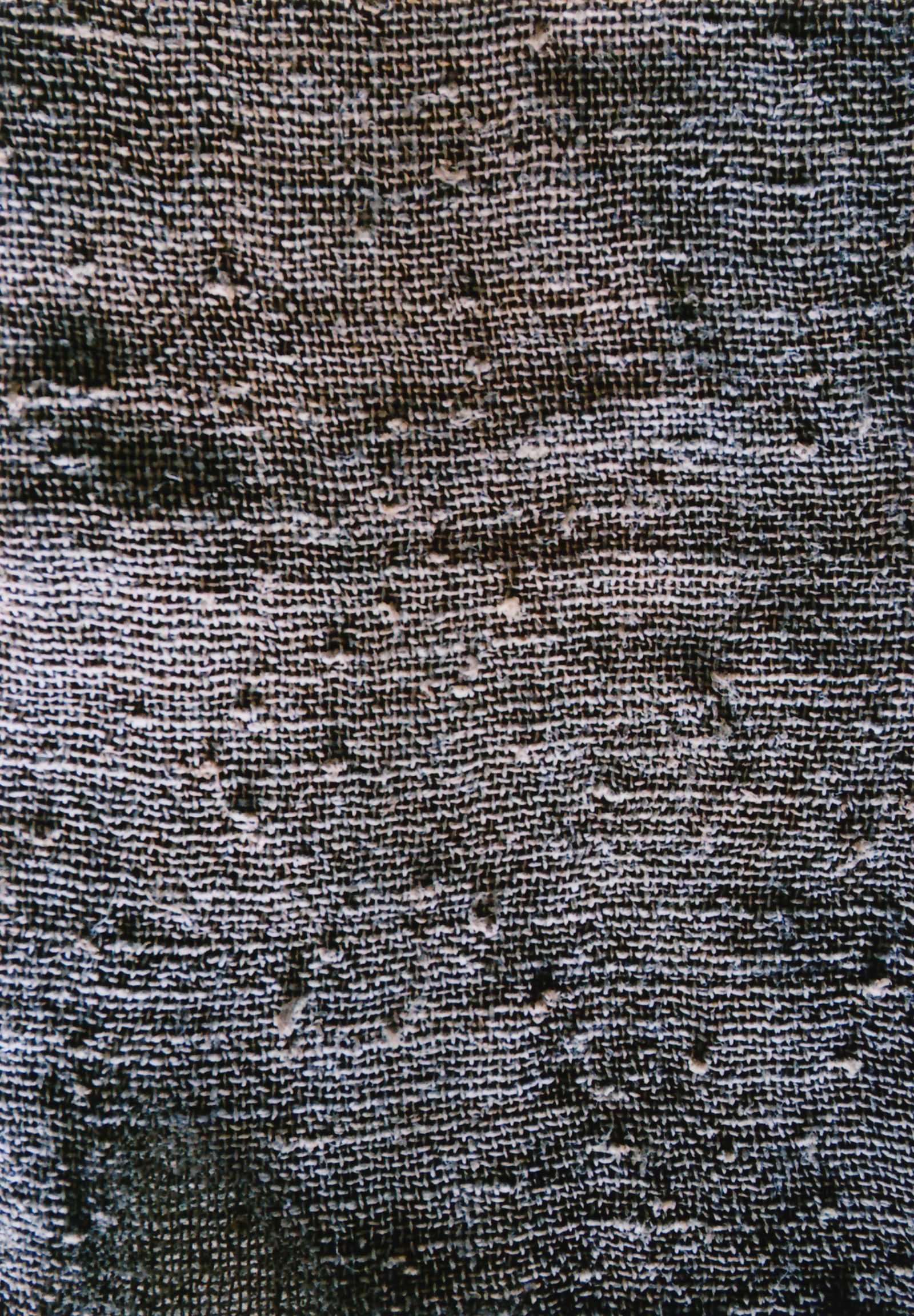
《大井谷の冬景色》1971年 撮影:隅田正三
島根県立石見美術館
2021年3月20日(土・祝) − 5月16日(日)
午前9時30分-午後6時(展示室への入場は閉館の30分前まで)
毎週火曜日休館(5月4日は開館)
本展は、日本の様々な地域に残された「自然布」から、各地の風土と一体となった人々の暮らしや自然観、精神性をみつめ、人と自然とのこれからの関係について展望しようとするものです。日本古来の素材や手漉き和紙に関する研究を続けてきた「コズミックワンダーと工藝ぱんくす舎」を招聘し、その独自の視点で選出された「自然布」と糸車や織機などの紡織用具、布の組織痕が残る縄文時代の土器片、そして「コズミックワンダーと工藝ぱんくす舎」による手漉き和紙を用いた新作とパフォーマンス、撮り下ろしの映像や写真をご覧いただきます。
かつて人々は暮らしの身近にある草木から繊維を績み、布にして、衣服や暮らしの道具としていました。それぞれ生育に適した環境や繊維としての特性の異なる藤、葛、梶、楮、大麻、苧麻、榀、芭蕉、オヒョウなどが用いられ、それゆえ「自然布」には、それが生み出された地域ごとに特徴的な暮らしの文化が色濃く反映されています。
繊維を取るところから全行程が手作業でなされる「自然布」づくりは、大変な根気を要すもので、その苦労は今日では想像もつかないほどです。貴重な布は尊ばれ、どの地域でも大切にされました。藤織がなされた島根では、ボロになった布は叩いて紙にし、最後まで無駄なく使ったとも伝えられます。
今日、自然と人間との関係は再考すべき段階になっています。
私たちは便利な暮らしの影で、自ら地球を汚し、住みにくい環境へと変えてきました。一方で、太陽の光を浴び、地球が生み出すエネルギーの恩恵を得て命を繋ぐあり方はいつの時代も同じです。すぐそばにある自然に包まれ、あるものを大切にして生きていた時代の布がいま、私たちに見せるのはどんな姿でしょうか。沢山の情報が溢れる現代において、「自然布」や手漉き和紙に宿る気配に、私たちが選び得る未来の姿の一つが映されているのかもしれません。原始の布とかみ、そしてそれらに共鳴して生み出された作品から未来を見つめます。
________________________________________
日、月、かみ、仏を尊ぶ言葉にノノがある
京都丹後の藤織りの里、上世屋では
かみから藤布の織り方を教わったという伝説がある
上世屋では藤織のことを親しみを込めてノノと呼ぶ
藤、葛、梶、楮、大麻、苧麻、榀、芭蕉、オヒョウ
人は草木から繊維を績み衣にした
地球の草木には、宇宙と地球の愛と叡智が内包されていて
私達は草木を布とし、纏うことによって
それらと一体となる感覚を身近に感じるものとしてきた
その働きは、無意識のうちに宇宙へと繋がり
人の意識はすべてと繋がってゆく
そこにノノが現れる
コズミックワンダーと工藝ぱんくす舎
________________________________________
関連プログラム
スペシャルトーク「ノノをめぐる」
近世麻布研究所を主宰し、麻布を中心に自然布の収集・研究を続けている現代美術家の吉田真一郎さんと、京都府宮津市の藤布の里、上世屋に移り住み、藤布の保存・継承に尽力している井之本泰さんをお招きし、お二人の活動とご研究について伺います。
日時:4月24日(土)14:00 — 16:00 延期になりました。
日時が決定しましたらお知らせいたします。
会場:グラントワ小ホール(聴講無料)
出演:吉田真一郎(近世麻布研究所所長)、井之本泰(丹後藤織り保存会顧問)
聞き手:工藝ぱんくす舎(前田征紀、石井すみ子)
ギャラリートーク
日時│4月10日(土)、5月16日(日) いずれも14時から
会場│展示室C
当日先着10名/参加無料(ただし観覧券またはミュージアムパスポートが必要)
◎ 新型コロナウイルス感染拡大防止のため、関連プログラムは定員を通常の半分にしています。また、美術館への入館はマスクの着用、入室前の検温、緊急連絡先の記入などをお願いしております。
◎ 施設の開館状況、展覧会の会期、関連プログラムなどが変更・中止となる可能性があります。
◎ご来館の前には、当館ホームページにて最新の情報をご確認ください。
________________________________________
COSMIC WONDER
1997年、 前田征紀を主宰として設立。「精神に作用する波動」としての衣服、美術、書籍など多様な表現の領域を超えて展開。2015年「ミエルかみ」展(京都•gallery白田)におけるパフォーマンス「かみのひかりのあわ 水会」を皮切りに、工藝ぱんくす舎と共に作品制作•発表を開始。2017年に「COSMIC WONDER 充溢する光」展(島根県立石見美術館)、2019年に「COSMIC WONDER Harmonic Meditation」(香港•Taka Ishii Galley)を開催。
工藝ぱんくす舎
前田征紀と石井すみ子の精神の空間を創造する美術ユニット。2015年パフォーマンス「かみのひかりのあわ 水会」(gallery白田)、 2016年「お水え いわみのかみとみず」展(島根県立石見美術館)、 2017年「かみ」展(銀座・資生堂ギャラリー)を発表。手漉き和紙、自然布について独自の感性から研究を続けている。
________________________________________
主催│島根県立石見美術館、国立新美術館、読売新聞社、しまね文化振興財団、日本海テレビ、山陰中央新報社、中国新聞社、文化庁、独立行政法人日本芸術文化振興会
協力│七彩
後援│芸術文化とふれあう協議会、NHK松江放送局
観覧料
当日券 一般1,200(950)円 大学生600(450)円 小中高生(300)250円
前売券 一般1,000円 大学生500円 小中高生200円
上記観覧料で、「ファッション イン ジャパン 1945-2020 流行と社会」もご覧いただけます。
*( )内は20名以上の団体料金 *小中高生の学校利用は入場無料
*各種障がい者手帳または被爆者健康手帳をお持ちのかたおよびその介助者(1名様まで)は入場無料
*前売券は、ローソン各店(Lコード62313)、グラントワ総合受付カウンターでお求めになれます。
アクセス
● 石見交通バス「グラントワ前」下車徒歩1分
● JR益田駅から徒歩15分
● 萩・石見空港からJR益田駅まで連絡バス約15分
● 浜田自動車道浜田ICから自動車約50分
● JR新山口駅から益田駅まで特急約90分
◎ 駐車場あります(約240台・無料)
島根県立石見美術館(島根県芸術文化センター「グラントワ」内)
〒698−0022 島根県益田市有明町5−15
電話 0856—31—1860(代表) FAX 0856−31−1884(代表)
MAIL zaidan@grandtoit.jp http:// www.grandtoit.jp/

工藝ぱんくす舎《鬼怒沼の髪すき沼》2020年、撮影:前田征紀
山の竜宮といわれる栃木県鬼怒沼。乙姫のはたおり伝説がのこる

工藝ぱんくす舎《木頭村 那賀川での楮さらし》2020年 撮影:前田征紀
山深い徳島県那賀郡那賀町木頭には、太布作りが現在も継承される

《上講武の敷布》藤、昭和初期、個人蔵 撮影:仲川あい
島根県松江市鹿島町の山間部、上講武では藤織りの習俗が記録された
COSMIC WONDER and Kogei Punks Sha “NONO a native spirit of Kami and Cloth”
FASHION IN JAPAN 1945-2020 Special exhibition for Shimane
Period: March 20 (Sat) – May 16 (Sun), 2021
Venue: Iwami Art Museum Exhibition room C Shimane Arts Center “Grand Toit”
Opening Hours: 9:30-18:00 *Last admission 30 minutes before closing.
Closed: Tuesdays *Open on May 4 (Tue.)
This exhibition has been realized with hopes to find future connections between man and nature. By examining the ways of life of the people who live hand in hand with the envinronment they inhabit, their views on nature, or spirituality, reflected in “natural fabrics” which have been suceeded in various parts of Japan.
We proudly invite “Cosmic Wonder and Kogei Punks Sha”, who have continued to work with different material and handmade washi paper, of which culture has been deeply rooted in Japan since the ancient times, to show the “natural fabrics” chosen from their unique perspective, spinning devices such as the spinning wheel and loom, and potsherds of Jomon period earthernware, which retain marks of fabric textures, with new work and performances using handmade Japanese washi, as well as new video and photography work by the unit.
In the past, people have spun fiber from plants taken from their surroundings, making fabrics, then making them into clothing and tools to sustain their lives.
These cloths generally called “natural fabrics” are made from fuji (wisteria), kuzu (arrowroot), kozo (paper mulberry), hemp, ramie, shinanoki (Japanese linden), basho (Japanese banana plant), ohyo (Manchurian elm), depending on the environment in which they are found growing or on their diverse properties as fabric. They deeply reflect the culture unique to each area, based on the ways of life which have nurtured them.
The making of “natural fabrics”, where the whole process is done by hand, starts from taking the fiber, which requires much perseverance, and one cannot imagine how much work it would take if it were to be done today. Such precious fabrics have been highly regarded and cherished in many a region.In Shimane, where there is a tradition of fuji-ori weaving, the worn boro fabric was battered back to pulp, as they say it was used to the end, without letting it go to waste.
Today, we have come to a stage where we need to reevaluate the relationship we have between nature and man.
At the expense of our convenient lifestyles, we have contaminated our planet and altered our environment so far as to make it inconvenient for us to live in.On the other hand, how our lives are passed on, on behalf of the energy provided by this earth, will not change no matter what period we live in.
What do they show us now, these fabrics that exist from the times we were nurtured by the nature around us, and cherished what we had? In present times, where there is an abundance of information, our future options we can choose from may be reflected in the very presence of these “natural fabrics” and handmade paper.
_________________________________________
NONO stands as a word to worship the day/sun, moon, god and buddha.
In Kamiseya, a town with a tradition for fuji-ori, in the Tango region of Kyoto, there is a legend that it was god who taught the people how to weave the fuji cloth.
In Kamiseya, fuji-ori is affectionately called NONO.
Fuji(wisteria), kuzu(arrowroot), kaji(original paper mulberry), kozo(paper mulberry), hemp, ramie, shinanoki(Japanese linden), basho(Japanese banana plant), ohyo(Manchurian elm). People have spun fibers taken from plants into cloths.
As love and wisdom of the universe and earth are embodied in plants of this earth, we make cloths out of these plants, and by wearing them, we were able to feel connected to the idea of being one with them.
The workings connect us subconsciously to the universe, and our consciousness as human beings will connect us with all in its entirety.This is where the NONO will emerge.
Cosmic Wonder and the Kogei Punks Sha
_______________________________________________________________
We will invite Shinichiro Yoshida, the contemporary artist and director of the Research Center for Early-modern Hemp, who continues to collect and research natural textiles with a focus on hemp cloth, and Yasushi Inomoto, who has moved to Kamiseya in Miyazu, Kyoto, the hometown of fuji cloth, in order to ardently preserve and succeed in its tradition, to hear about their work and research.
Date: Saturday, April 24, 2021 14:00-16:00
Venue: Lecture Room
Capacity: 25(by order of application)
Fee: Free Admission
Speakers: Shinichiro Yoshida (Director of the Research Center for Early-modern Hemp), Yasushi Inomoto (Advisor to the Tango Fuji-ori Preservation Society)
Listener: Kogei Punks Sha(Yukinori Maeda, Sumiko Ishii)
Gallery Talk
Date: April 10(Sat.), May 16(Sun.),2021 14:00-
Venue: Exhibition room C
Capacity: 10(by order of application)
Fee: Free Admission(however, an exhibition ticket or museum passport is required)
______________________________________________________________
Also on: “Fashion In Japan 1945-2020 — Mode and Society” Exhibition room A & D
The exhibition will reexamine Japanese fashion from the postwar to the present. It will look at the future of fashion by examining it from both the designer, who create the clothes, and its consumer, while focusing on the media that has bridged the connection between the two.
_______________________________________________________________
COSMIC WONDER
COSMIC WONDER was founded in 1997 by Yukinori Maeda. COSMIC WONDER is a conceptual project comprising various modes of expression from clothing, artwork and publishing to performance.Since the performance “Kamino-hikarino-awa Water Ceremony” in 2015 for the exhibition “MIERU Kami” (Gallery Hakuden, Kyoto), COSMIC WONDER had begun to produce and present their work together with Kogei Punks Sha. It has held exhibitions “COSMIC WONDER: Lightness of Light” (Iwami Art Museum in Shimane prefecture) in 2017, and “COSMIC WONDER: Harmonic Meditation” (Taka Ishii Gallery, Hong Kong) in 2019.
Kogei Punks Sha
Kogei Punks Sha is an artistic unit creating space for human spirit. Formed by Yukinori Maeda and Sumiko Ishii.
Presented the performance “Kamino-hikarino-awa Water Ceremony” (Gallery Hakuden, Kyoto) in 2015, the exhibition “Omizue: Iwamino-kamito-mizu” (Iwami Art Museum, Shimane) in 2016, “Kami” (Shiseido Gallery, Ginza) in 2017. With a unique sensibility, the unit continues its research on handmade washi and natural cloths.
_______________________________________________________________
Organized by; Iwami Art Museum, Shimane; The National Art Center, Tokyo; The Yomiuri Shimbun; Culture Foundation of Shimane Prefecture; Nihonkai Telecasting Co.,Ltd; The San-in Chuo Simpo Newspaper Co.,Ltd; The Chugoku Shimbun; Agency for Cultural Affairs; Japan Arts Council
Supported by; Council to interact with art and culture; JAPAN BROADCASTING CORPORATION MATSUE STATION
Entrance Fees
Tickets for today; Adults 1200(950)yen, College Students 600(450)yen, Middle, and High School Students 300(250)yen
Advance ticket; Adults 1000 yen, College Students 500 yen, Middle, and High School Students 200 yen
The admission listed above includes the exhibition “Fashion in Japan 1945-2020”.
*For groups of 20 or more
Free admission for school visits for elementary, middle and high school students.
Free admission for holders of the Disabled Person’s Handbook or the Atomic Bomb Survivors Handbook and person’s assisting (limited to one person).
Advance Tickets available at Lawson stores (L Code 62313) and Grand Toit General Information Counter.
_______________________________________________________________
Access
Iwami Kotsu Bus: Get off at “Grand Toit Mae” bus stop (a 1 minute walk).
A 15 minute walk from JR Masuda Station.
A 15 minute bus ride using the airport bus from Hagi-Iwami Airport to JR Masuda Station.
A 50 minute drive from the Hamada Interchange on the Hamada Expressway.
A 90 minute train ride from JR Shin Yamaguchi Station to JR Masuda Station.
※Free parking available(240 parking spaces)
Iwami Art Museum (Shimane Arts Center “Grand Toit”)
5-15 Ariake-cho, Masuda-shi, Shimane-ken, 698-0022 JAPAN
TEL: +81-856-31-1860 FAX: +81-856-31-1884
E-mail zaidan@grandtoit.jp http:// www.grandtoit.jp/